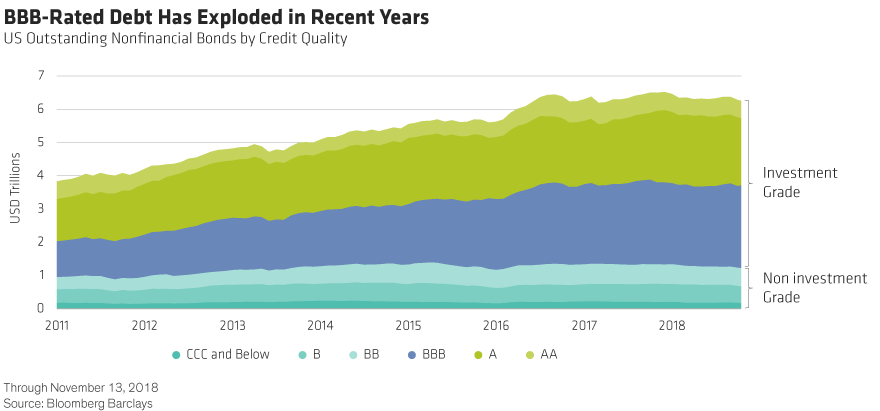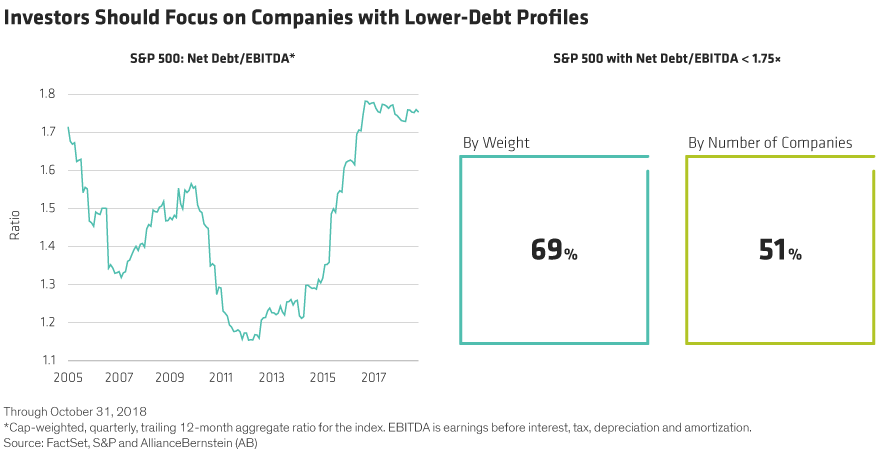
Contributed by Frank Caruso and John Fogarty of AllianceBernstein.
US corporate debt has surged over the past decade. As rates begin to rise from historic lows, focusing on quality companies with healthy balance sheets can help equity investors avoid danger zones.
Ultralow interest rates have fueled financial markets for years. Many companies have taken advantage of the comfortable financing conditions to increase borrowing. But as conditions change, higher rates could force investors to confront some nasty side effects of the easy-money policy.
US outstanding nonfinancial bonds have risen by 63% to $6.3 trillion since 2011 (Display). And the S&P 500’s net debt/EBITDA—a measure of corporate indebtedness—ballooned by more than 50% in late 2011 to 1.75x today. What’s really worrying, though, is how much of that borrowing binge is being driven by lower-quality companies. Debt with a BBB credit rating—at the lower end of investment-grade credit—has more than doubled since 2011 and represents about 50% of the US investment-grade bond index today.

GE’s troubles illustrate the risks. In recent weeks, the company’s shares have plunged and its credit ratings were cut to BBB, putting it on the brink of slipping into noninvestment-grade status. Although GE’s troubles are rooted in its history of excessive borrowing to fund bad acquisitions and share buybacks, its predicament should be ringing alarm bells for equity investors. While some BBB issuers still have solid fundamentals and will perform well over the long term, companies that have borrowed too much, like GE, could be pushed over the edge as rates rise.
Deteriorating Debt Quality and Rising Rates: A Toxic Combination
High rates would boost financing costs for companies saddled with too much floating debt. Rising inflation could increase costs and squeeze profit margins, which could cause coverage ratios to deteriorate and trigger debt downgrades. This scenario, in turn, would push funding costs even higher in a potentially devastating debt spiral. To make matters worse, when the debt squeeze comes, companies that levered up to buy back shares at high valuations could be forced to issue equity at trough valuations to delever.
Of course, investors should always scrutinize company balance sheets. These days, we think it’s more important than ever. Deteriorating debt quality and rising rates are a toxic combination that could ultimately undermine earnings and stock prices, in our view. There are signs that this situation is already happening. Our research shows that stocks of US companies with high leverage underperformed stocks of companies with low leverage by 7.2% as of this year through the end of October.
Three Measures of Quality
So what should investors look for in this environment? We think companies with solid long-term return potential for today’s complex environment should score well on three measures of quality: low debt, self-funding profitability and low cyclicality.
- Low debt: Start by focusing on companies with healthy balance sheets. Look for companies that have low debt-to-EBITDA ratios. Today, just over half the companies in the index have a lower debt/EBITDA ratio than the benchmark’s 1.75x (Display).

- Self-funding profitability: Companies with low leverage and high levels of profitability are relatively resilient to the whims of market funding. When funding costs rise—or the funding window closes—their operations should not be affected because they don’t rely on the market to pay their bills or invest in expansion. We believe return on assets (ROA) is a reliable measure of profitability. Companies whose ROA exceeds asset growth are self-funding. These companies should be able to reward shareholders by returning surplus cash as dividends or in share buybacks, even in a more challenging market.
- Low cyclicality: Consistently high profitability tells you a lot about a company’s business. Growth rates can vary dramatically for most companies through the macroeconomic cycle. But businesses that can maintain long-term profitability typically have profit models capable of performing well regardless of the macroeconomic backdrop. Companies with commodity-like businesses, such as banks or materials, often apply leverage to boost ROA from chronically low levels. Differentiated and defensible businesses with high ROA—and low leverage—can typically be found in sectors such as healthcare and technology, and parts of the consumer sectors.
US capital markets are at a critical juncture with profits peaking and the credit cycle at a late stage. Earnings are being flattered by tax reform and share buybacks. Lower taxes make profit margins look fatter—and make debt look more manageable. But the risks are real. Make sure your portfolio owns high-quality businesses with sales growth, pricing power, competitive advantages and low debt that can withstand changing market conditions and deliver long-term returns.
The views expressed herein do not constitute research, investment advice or trade recommendations and do not necessarily represent the views of all AB portfolio-management teams and are subject to revision over time.


Leave a Reply